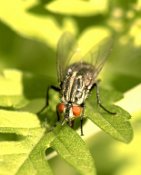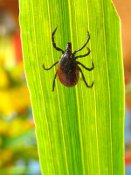Tularemia
Tularemia
Tularemia is a naturally-occurring, tick transmitted disease of rabbits and rodents caused by the bacterium Francisella tularensis. Infected rabbits usually die, showing no signs of trauma. In Bernalillo County, tularemia infected animals and human cases have occurred mainly in the East Mountains communities and the Western Foothills of the Sandia Mountains. However, cases have been recorded in North Albuquerque Acres and the Rio Grande Valley.
Although tularemia can be contracted throughout the year, transmission is more common in April-October and does overlap with plague in its seasonality and locality.
Reporting a Disease Concern
Call 311 to report a dead rabbit or rodent on your property that has no obvious signs of trauma. The Urban Biology Division will contact you and arrange for pick up of the animal and arrange for disease testing. The City of Albuquerque accepts reports of disease concern from all of Bernalillo County.
Animals of Concern
Tularemia is usually associated with lagomorphs (Jack rabbits, cottontails, and domestic rabbits). However, rodents such as squirrels, chipmunks, woodrats, prairie dogs, and mice can also be a concern.
Domestic cats and dogs can also contract the disease and become sick.
Transmission
 Tularemia is most commonly transmitted through the bite of an infected tick or deer fly.
Tularemia is most commonly transmitted through the bite of an infected tick or deer fly.- Direct contact with infected tissue usually occurs when animal carcasses are removed from a property without wearing gloves, protective eyewear, or a mask. Historically, cases usually involved hunters who field dressed infected rabbits without wearing gloves allowing the bacteria to enter the body through open cuts or abrasions in the skin.
- Transmission can also occur through the ingestion of contaminated food or water.
- It is important to never fling a dead animal. Bacteria particles can become aerosolized and cause infection through inhalation.
Symptoms
Human
Symptoms usually appear 3-5 days after exposure, but can take as long as fourteen days to appear.
- Fever and/or chills (100.4-104°F)
- Headaches
- Muscle aches
- Dry cough and/or sore throat
- Progressive weakness and lethargy
- Joint pain
- Ulcers on the skin at the source of infection
- Swollen or painful lymph nodes/eyes
- Pneumonia (associated with chest pain, cough, and difficulty breathing)
- If you are experiencing symptoms described here seek medical attention;with early diagnosis and antibiotics this disease is easily treatable.
- Remember to tell the medical professional about any potential exposures with rabbits or rodents
Pets
- Cats with tularemia may have a high fever, a lack of appetite and act sluggish.
- Dogs with the disease have a high fever, nasal and eye discharge and open skin sores at the site of infection.
- Pets experiencing these symptoms should be taken to a veterinarian for proper diagnosis.
- Be sure to explain any potential exposure or contact with rodents or rabbits to the veterinary staff.
- If your pet is diagnosed with tularemia, the New Mexico Department of Health will be notified. If you are in Bernalillo County, the City of Albuquerque's Urban Biology Division will also be notified.
- Upon notification of a domestic animal diagnosis, our division will follow-up with the pet owner.
Prevention Strategies
 Remove rodent harborage: clean-up woodpiles, uncovered garbage, scattered pet food, and rock piles around your home.
Remove rodent harborage: clean-up woodpiles, uncovered garbage, scattered pet food, and rock piles around your home.- Prevent pets from hunting by keeping cats indoors and dogs on leash.
- Keep pets on year-round flea and tick control. Ask your veterinarian for recommendations.
- Wear insect repellent, containing DEET, and protective clothing when outdoors.
- Check yourself for ticks after being outdoors.
- Wear water resistant gloves, eyewear, and a mask when handling animals.
- Never fling a dead animal, always carefully double bag and seal.
- Check your property prior to yard work such as mowing, digging, and moving wood piles.
